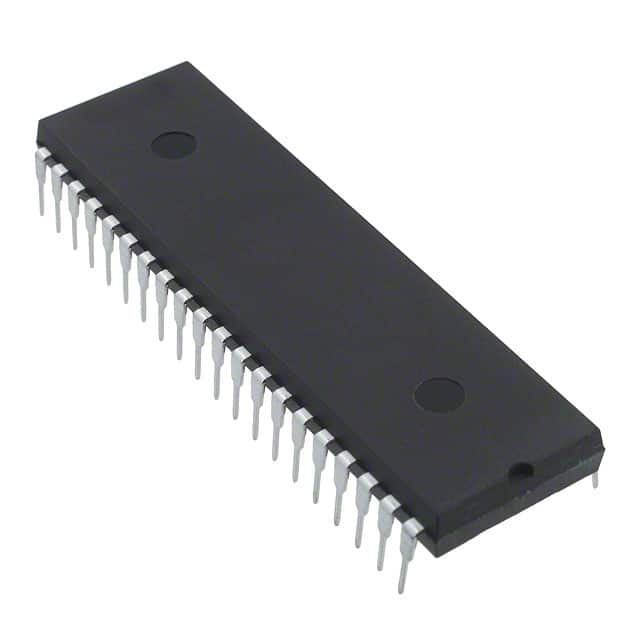Xem thông số kỹ thuật để biết chi tiết sản phẩm.

N78E055ADG
Product Overview
- Category: Microcontroller
- Use: Embedded systems, control applications
- Characteristics: High-performance, low-power consumption
- Package: DIP-20, SOP-20
- Essence: 8-bit microcontroller with integrated peripherals
- Packaging/Quantity: Tape and reel, 2500 units per reel
Specifications
- Architecture: 8051 compatible
- CPU Speed: Up to 24 MHz
- Program Memory: 8 KB Flash
- Data Memory: 256 bytes RAM
- I/O Pins: 15
- Timers/Counters: 2 x 16-bit
- Serial Communication: UART, SPI, I2C
- Analog-to-Digital Converter: 10-bit, 8 channels
- Operating Voltage: 2.4V - 5.5V
- Operating Temperature: -40°C to +85°C
Detailed Pin Configuration
The N78E055ADG microcontroller has a total of 20 pins. The pin configuration is as follows:
- P3.0 / RXD (UART Receive)
- P3.1 / TXD (UART Transmit)
- P3.2 / INT0 (External Interrupt 0)
- P3.3 / INT1 (External Interrupt 1)
- P3.4 / T0 (Timer 0 External Input)
- P3.5 / T1 (Timer 1 External Input)
- P3.6 / WR (Write Control for External Data Memory)
- P3.7 / RD (Read Control for External Data Memory)
- XTAL1 (External Crystal Oscillator Input)
- XTAL2 (External Crystal Oscillator Output)
- RST (Reset Input)
- P0.0 / AD0 (Analog Input 0)
- P0.1 / AD1 (Analog Input 1)
- P0.2 / AD2 (Analog Input 2)
- P0.3 / AD3 (Analog Input 3)
- P0.4 / AD4 (Analog Input 4)
- P0.5 / AD5 (Analog Input 5)
- P0.6 / AD6 (Analog Input 6)
- P0.7 / AD7 (Analog Input 7)
- VSS (Ground)
Functional Features
- 8-bit microcontroller with a wide range of integrated peripherals
- High-performance CPU with up to 24 MHz clock speed
- Low-power consumption for energy-efficient applications
- Flexible serial communication interfaces (UART, SPI, I2C)
- On-chip analog-to-digital converter for precise measurements
- External interrupt capability for event-driven applications
- Timers/counters for accurate timing and control
Advantages and Disadvantages
Advantages: - Versatile microcontroller suitable for various embedded systems - Integrated peripherals reduce external component count - Low power consumption extends battery life - Wide operating voltage range allows flexibility in power supply - Cost-effective solution for control applications
Disadvantages: - Limited program memory size (8 KB) may restrict complex applications - Limited data memory (256 bytes) may require external storage - Limited number of I/O pins (15) may limit connectivity options
Working Principles
The N78E055ADG microcontroller is based on the 8051 architecture. It operates by executing instructions stored in its internal Flash memory. The CPU fetches instructions from memory, performs calculations, and controls the integrated peripherals based on the program logic. The microcontroller communicates with external devices through its I/O pins and serial communication interfaces. It can be programmed using various development tools and programming languages.
Detailed Application Field Plans
The N78E055ADG microcontroller is suitable for a wide range of applications, including but not limited to:
- Home automation systems
- Industrial control systems
- Automotive electronics
- Consumer electronics
- Medical devices
- Internet of Things (IoT) devices
- Robotics
- Sensor networks
- Smart appliances
- Security systems
Alternative Models
- N76E003AT20: 1 KB Flash, 128 bytes RAM, DIP-20 package
- N76E616AT20: 16 KB Flash, 768 bytes RAM, DIP-20 package
- N76E885AT20: 32 KB Flash, 1 KB RAM, DIP-20 package
- N76E003AT21: 1 KB Flash, 128 bytes RAM, SOP-20 package
- N76E616AT
Liệt kê 10 câu hỏi và câu trả lời thường gặp liên quan đến ứng dụng N78E055ADG trong giải pháp kỹ thuật
Sure! Here are 10 common questions and answers related to the application of N78E055ADG in technical solutions:
Q: What is N78E055ADG? A: N78E055ADG is a microcontroller chip manufactured by Nuvoton Technology. It is commonly used in various technical solutions for embedded systems.
Q: What are the key features of N78E055ADG? A: Some key features of N78E055ADG include an 8051-compatible CPU core, 18KB flash memory, 256 bytes of RAM, multiple timers/counters, UART, SPI, I2C interfaces, and low power consumption.
Q: What are the typical applications of N78E055ADG? A: N78E055ADG is widely used in applications such as home automation, industrial control systems, consumer electronics, smart meters, and automotive electronics.
Q: Can N78E055ADG be programmed using C/C++ language? A: Yes, N78E055ADG can be programmed using C/C++ language. Nuvoton provides a development environment called Keil C51, which supports programming in C/C++.
Q: How do I program N78E055ADG? A: To program N78E055ADG, you need a programmer/debugger device that supports Nuvoton's programming protocol. You can use tools like Nu-Link or Nu-Link Pro for programming and debugging.
Q: Is N78E055ADG suitable for battery-powered applications? A: Yes, N78E055ADG is suitable for battery-powered applications due to its low power consumption. It has various power-saving modes that help extend battery life.
Q: Can N78E055ADG communicate with other devices or sensors? A: Yes, N78E055ADG has built-in UART, SPI, and I2C interfaces, which allow it to communicate with other devices or sensors. It can also be used as a master or slave in these communication protocols.
Q: Does N78E055ADG support real-time clock (RTC) functionality? A: No, N78E055ADG does not have a built-in real-time clock (RTC). However, external RTC modules can be connected to the microcontroller for timekeeping purposes.
Q: Can N78E055ADG handle analog signals? A: N78E055ADG does not have an onboard analog-to-digital converter (ADC). However, it can interface with external ADCs to handle analog signals if required.
Q: Is N78E055ADG suitable for high-performance applications? A: N78E055ADG is not designed for high-performance applications. It is more commonly used in low to medium complexity projects where cost-effectiveness and power efficiency are important factors.
Please note that the answers provided here are general and may vary depending on specific requirements and use cases.

